Featured Comment:
“Thank you for your recipe. We really enjoyed it. The only thing we changed was adding more chilies.”
– Hai
What is Motsunabe?
Motsunabe (もつ鍋) is a traditional type of “nabemono” (hot pot dish) primarily made with beef or pork offal, known as “motsu” or “horumon” in Japanese. It is a famous regional dish of the Hakata ward in Fukuoka city, located on the Western island of Kyushu.
Today, the standard motsunabe involves seasoning a bonito or seaweed broth with soy sauce or miso paste. Offal is added to the broth along with a generous amount of chives, cabbage, garlic, and optional chili peppers. Motsunabe is typically cooked in an aluminum pot over a flame, and once the ingredients are finished, the leftover broth is often enjoyed with ramen noodles.
I know that the idea of eating “motsu” or “horumon” can be quite intimidating, but motsunabe is truly delicious. The motsu not only melts into the broth to give it an amazing depth of flavor but also melts in your mouth. Motsunabe is the perfect dish for people trying motsu/horumon for the first time, I highly recommend it!
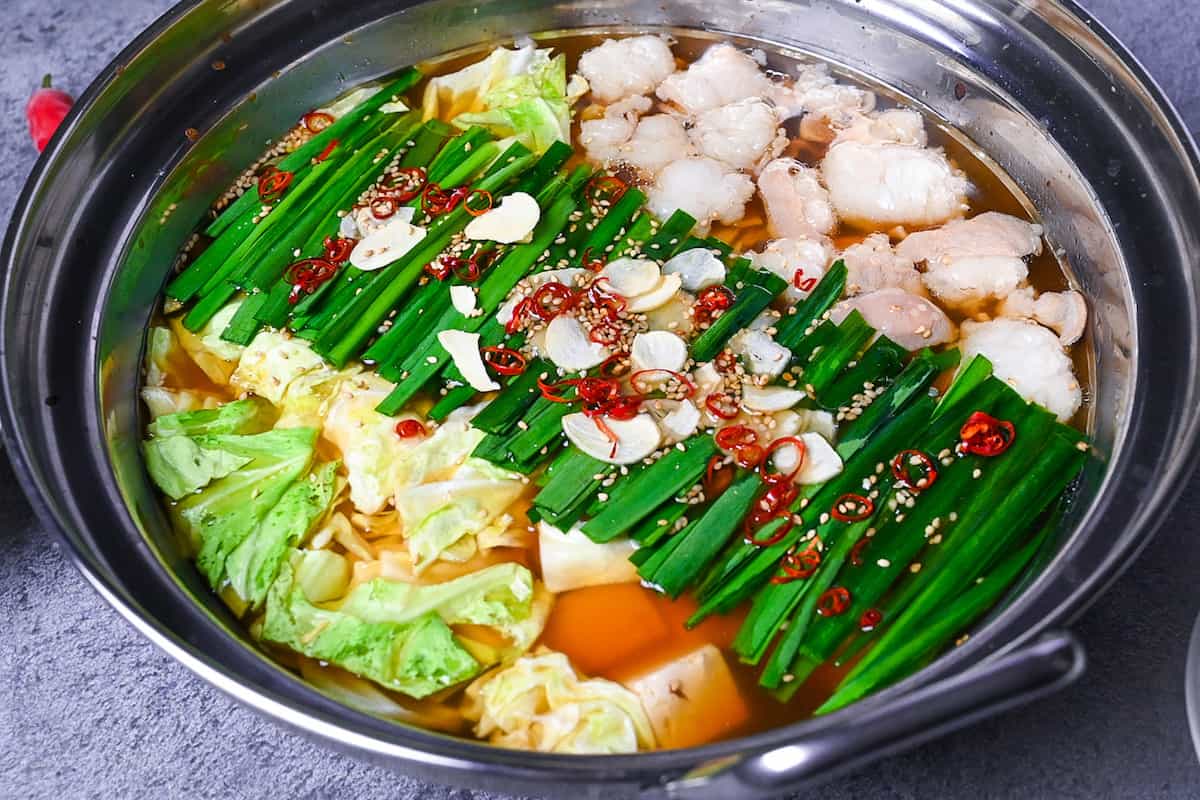
How to Choose the Right Offal
Some of you might wonder about the best type of offal to use when preparing motsunabe. In this section, I will provide an easy-to-understand introduction to recommended types of offal for motsunabe.
Firstly, it’s important to note that the essential ingredient for motsunabe is small beef intestines. This part is the most fatty, plump, and tender, and the fat carries a distinct sweetness. It’s safe to say that motsunabe is incomplete without this ingredient.
Some restaurants may include parts other than the small intestine in their “mix motsunabe”, like the large intestine or stomach parts (tripe) such as abomasum, rumen, and so on. While it’s uncommon to use pork or chicken hormone in motsunabe, some restaurants do offer it. However, in my opinion, beef small intestine is still the best choice.
Fresh small intestine of beef has pinkish muscles with visible milky fat and collagen. Keep in mind that it can darken over time if not properly treated. When selecting motsu, look for the “pink color” and examine the fat and the color of the collagen part. You can’t go wrong by choosing one with a clear and milky white appearance.
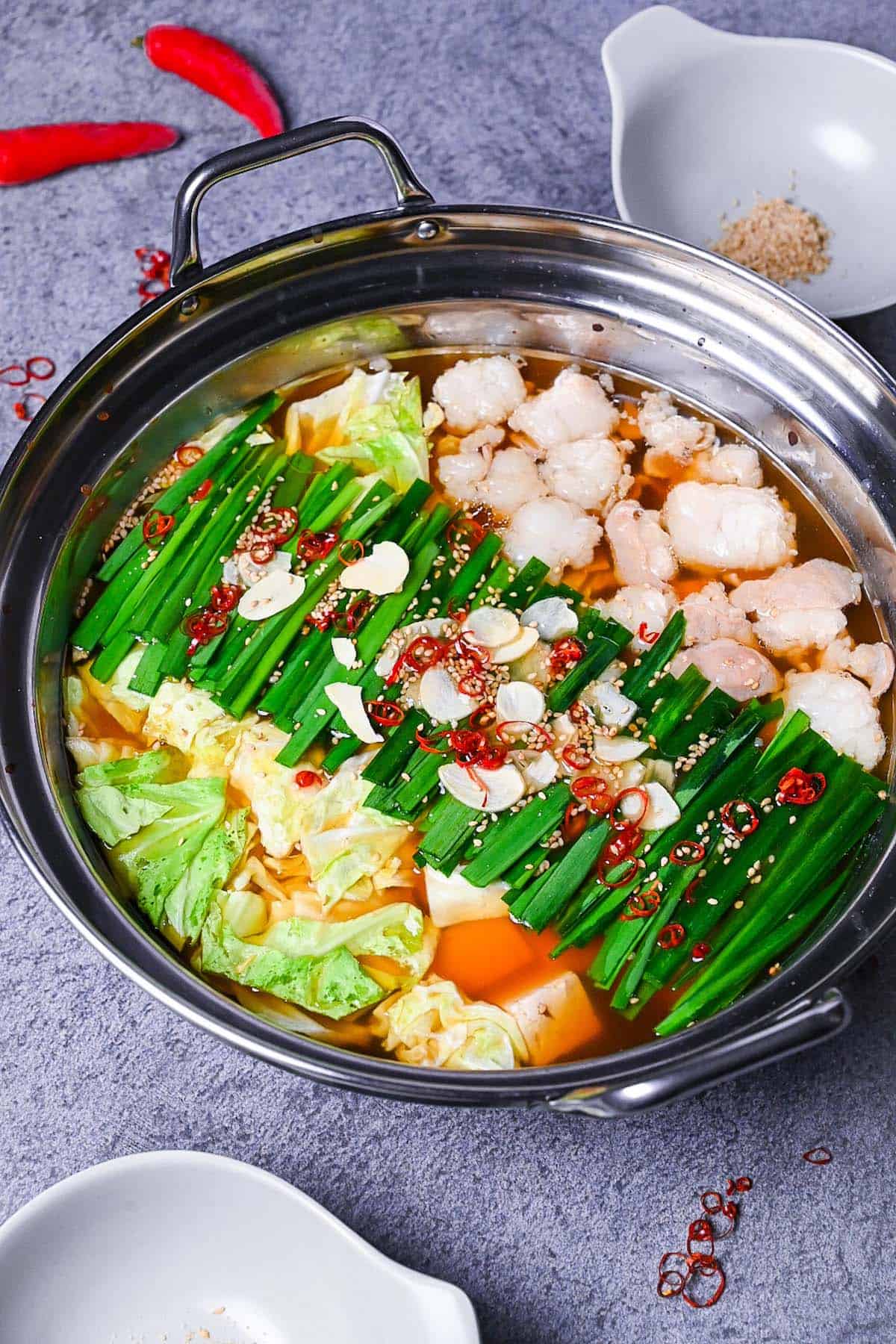
Ingredients & Substitution Ideas
- Beef Offal (Mostu): Select small intestines, pre-cut into bite-sized pieces.
- Vegetables: Get a tasty base going with green cabbage, burdock root (gobo), firm tofu, and garlic chives.
- Toppings: Spice up your motsunabe with a dash of dried red chili pepper for heat, garlic chips, toasted white sesame seeds, and ground sesame seeds.
- Cooked Champon/Ramen Noodles: You can use pre-cooked champon or ramen noodles. Here’s a pro tip: Cook them separately and give them a quick rinse after cooking to get rid of any excess starch. Ready to try something new? Why not try making your own ramen noodles? It’s a great weekend project!
- Dashi Broth: You can choose your dashi broth base: traditional awase dashi, vegan-friendly kombu dashi, or convenient dashi packets for a quick fix.
- Flavor Boosters: Mix together Chinese-style chicken bouillon powder, a blend of light and dark soy sauces, mirin, sake, oyster sauce, grated garlic and ginger, and sugar. These seasonings work well together to create a complex, satisfying broth.
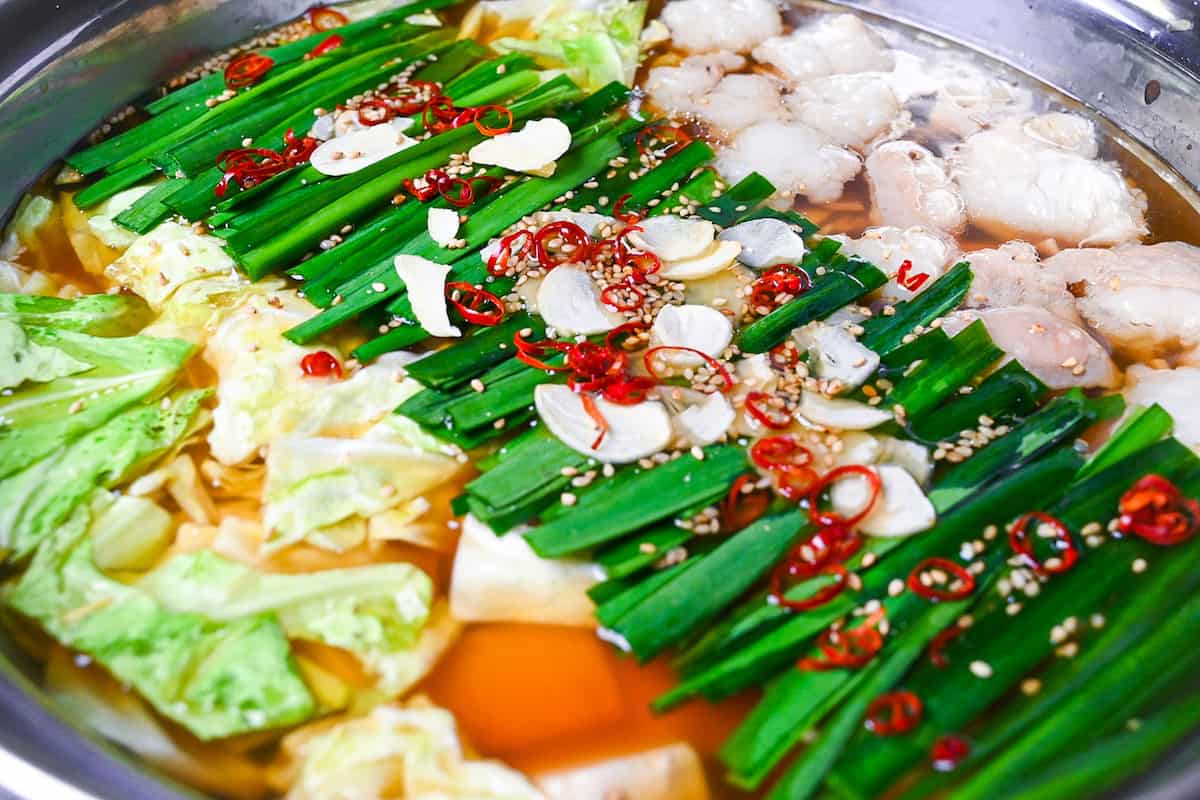
Visual Walkthrough & Tips
Here are my step-by-step instructions for how to make Authentic Motsunabe at home. For ingredient quantities and simplified instructions, scroll down for the Printable Recipe Card below.
The first step is to clean the motsu to remove any odors or unpleasant taste. To do this, first, place the motsu in a bowl of cold water and swish it around.
The motsu should be cut into small pieces, a little larger than bitesize. It’s easier to cut motsu using sharp kitchen scissors. I recommend cutting prior to washing.
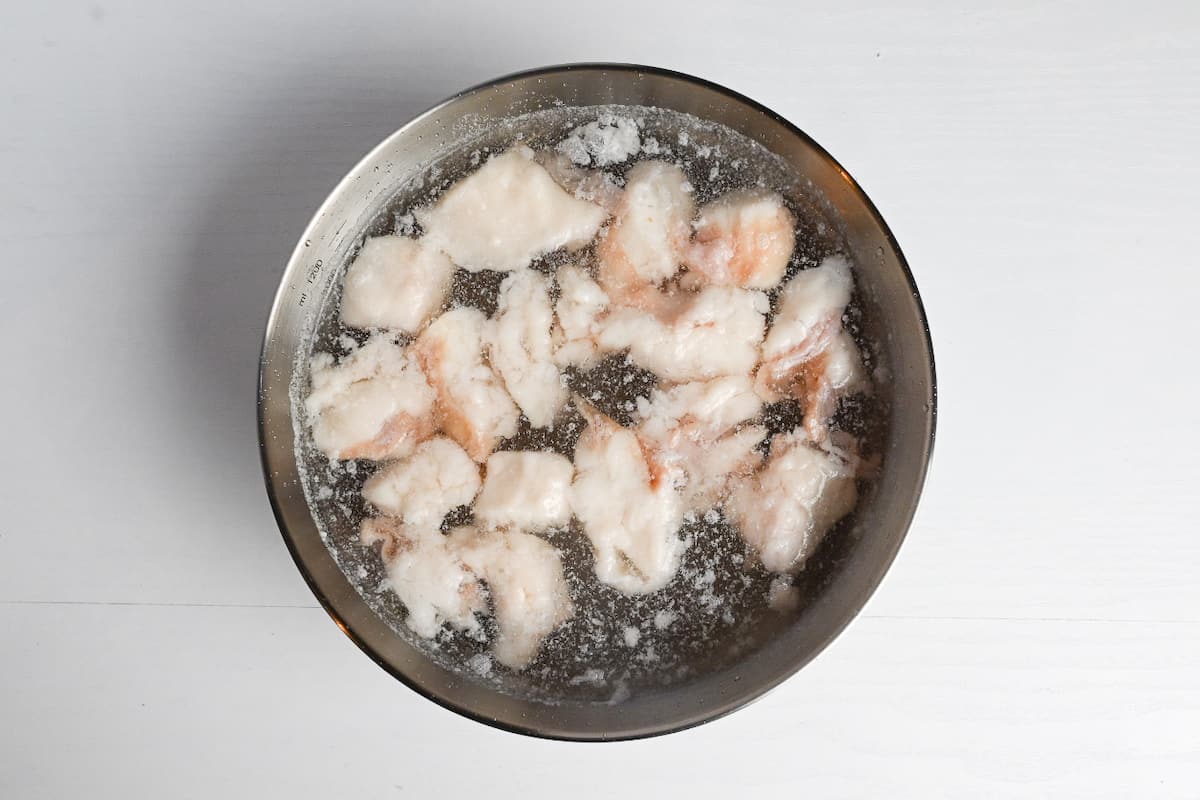
Place a sieve or colander over the sink and pour in the contents of the bowl to drain the water. Wash the bowl out, fill it with fresh cold water and set it aside for later.
Next, fill a heatproof bowl with freshly boiled water and place the sieve with the motsu inside the bowl for 10 seconds. (I used a saucepan of hot water instead.)
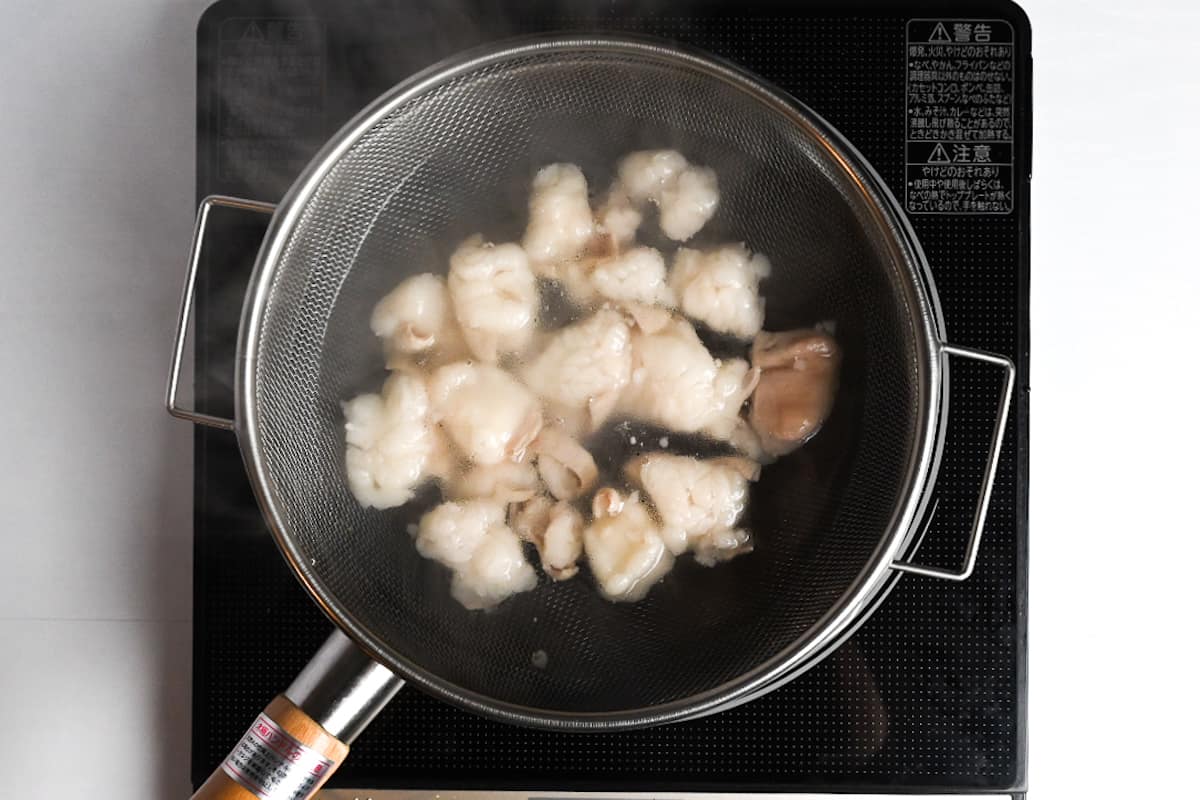
After 10 seconds, lift the sieve up and give it a shake, then pour the motsu back into the bowl of fresh cold water. These steps will remove any unwanted odors and improve the taste of the motsu!
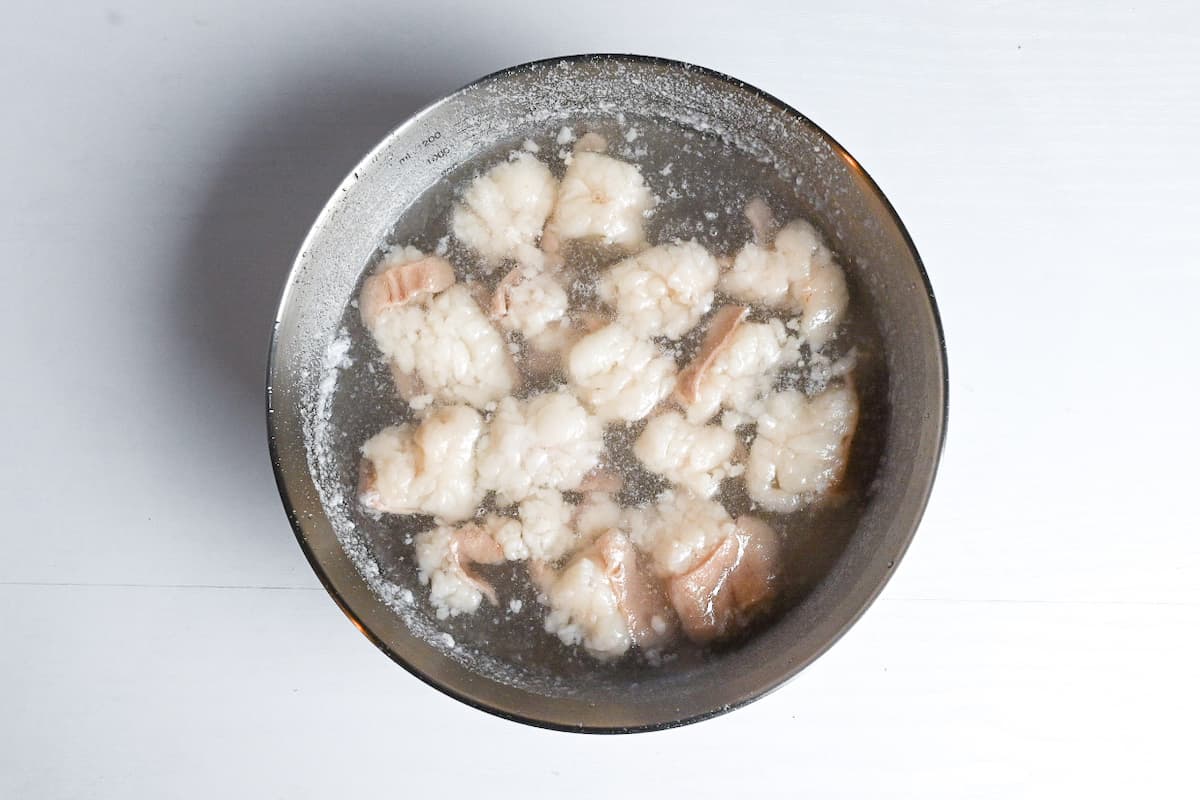
Drain the water before adding the motsu to the broth.
If you’re using burdock root, you will need to peel it and soak it before cooking. The skin is very thin, so I recommend using the back of a knife and carefully scrape it off (rather than using a peeler).
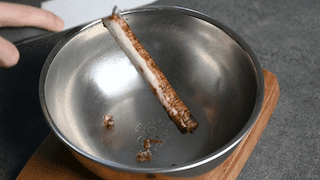
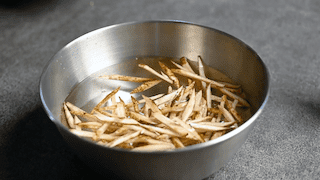
Thinly slice the burdock root and place it in a bowl of cold water for 5 minutes to improve the taste and avoid discoloration. Drain the water before adding the burdock root to the broth.
Making the broth is a simple process of mixing all the ingredients together in a pot. Motsunabe broth is made with dashi, chicken bouillon powder, light soy sauce, dark soy sauce, mirin, sake, light brown sugar, oyster sauce, grated garlic and grated ginger.
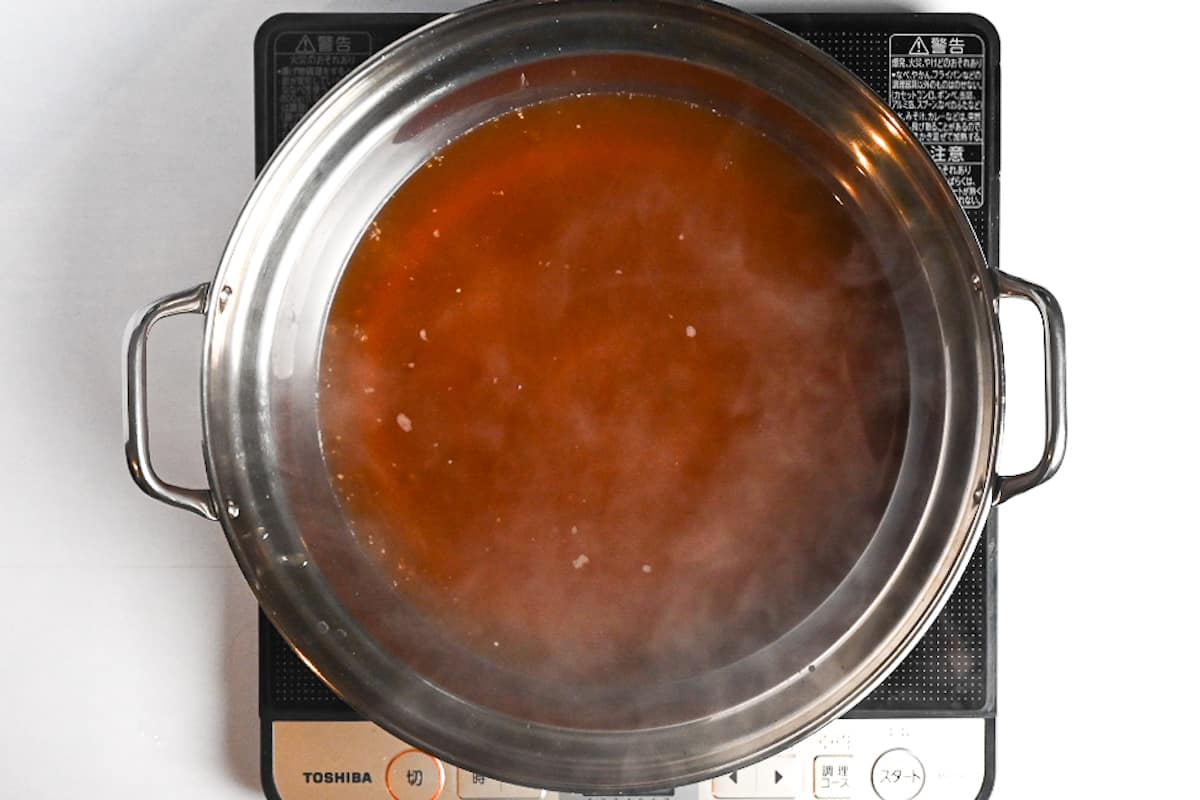
Once the ingredients are mixed, place the pot on the stove and bring it to a boil over medium heat.
Once the broth is hot, add the motsu, burdock root, tofu and roughly chopped cabbage.
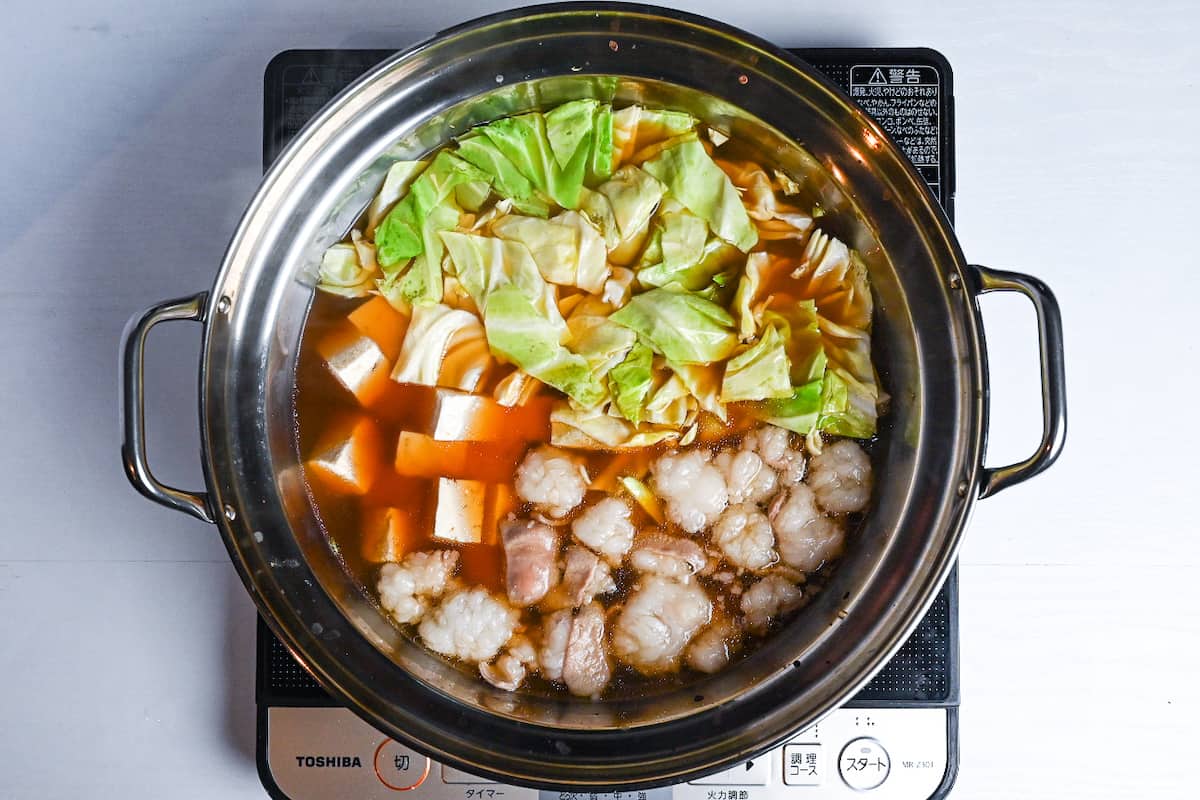
Lower the heat and simmer until the burdock root and cabbage have softened.
The toppings used on motsunabe are not only important for presentation but for flavor. Add the Chinese chives, chopped chili, garlic chips, and sesame seeds through the middle of the surface of the nabe.

Mix them in and allow to simmer for a few more minutes to allow the flavors to be absorbed into the broth.
In order to bring out the flavor in the motsunabe, place 1 tsp of ground sesame seeds in each serving bowl.
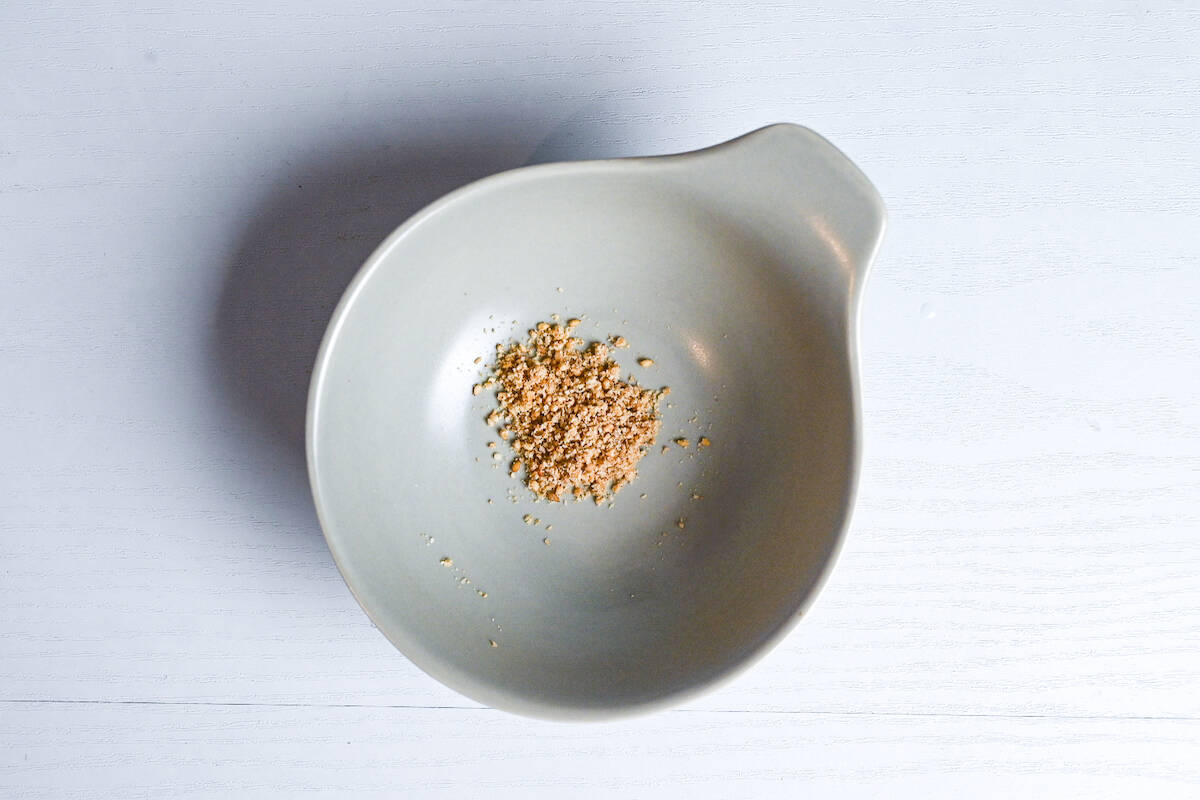
Hot pot dishes are typically served in the middle of the table, so dig in and enjoy!
Once all the ingredients have been eaten, it’s common to add cooked champon (or ramen) noodles to the broth. This part of the dish is something everyone looks forward to!
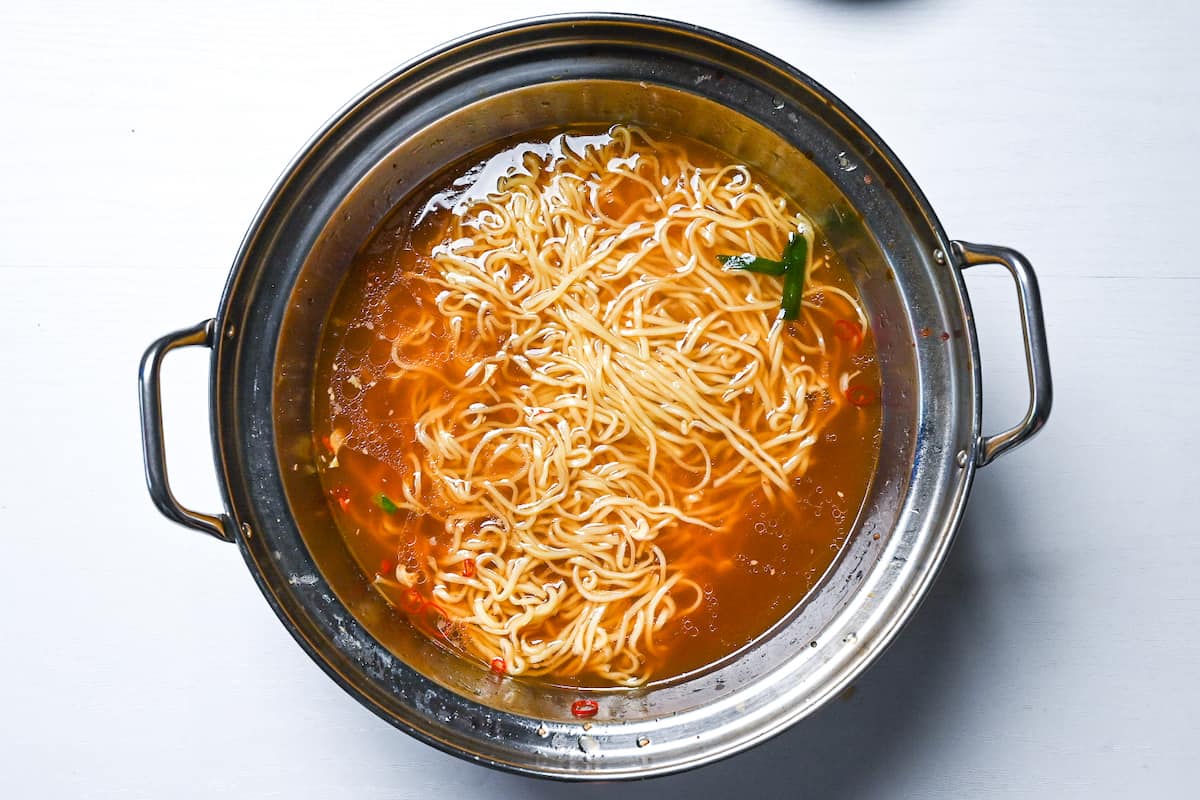
Be sure to boil the noodles separately before adding them to the soup. Preferably, rinse them after cooking to remove the excess starch and then place them in the broth.
FAQ
Here are answers to frequently asked questions I have received across all platforms, including here, YouTube, Instagram, and Pinterest. If you have any questions, feel free to send them to me anytime! It will be a big help for everyone in this community!
Yes, blanching is essential as it gets rid of any unpleasant odors from the small intestines and makes sure you’ll be eating them in the best condition.
The soy sauce amount might seem high for 800ml of dashi, but it’s balanced because the cabbage releases more water than you’d expect during cooking. This recipe relies on the natural water released from the cabbage, so if you use less cabbage than called for, or if you use vegetables with less water content, adjust the soy sauce accordingly. The great thing about hot pot dishes is how flexible they are. If the flavor is a bit too strong, you can always add a little water to get the taste just right.
Ramen (specifically chanpon noodles) is the traditional and recommended choice, but udon noodles also work well!
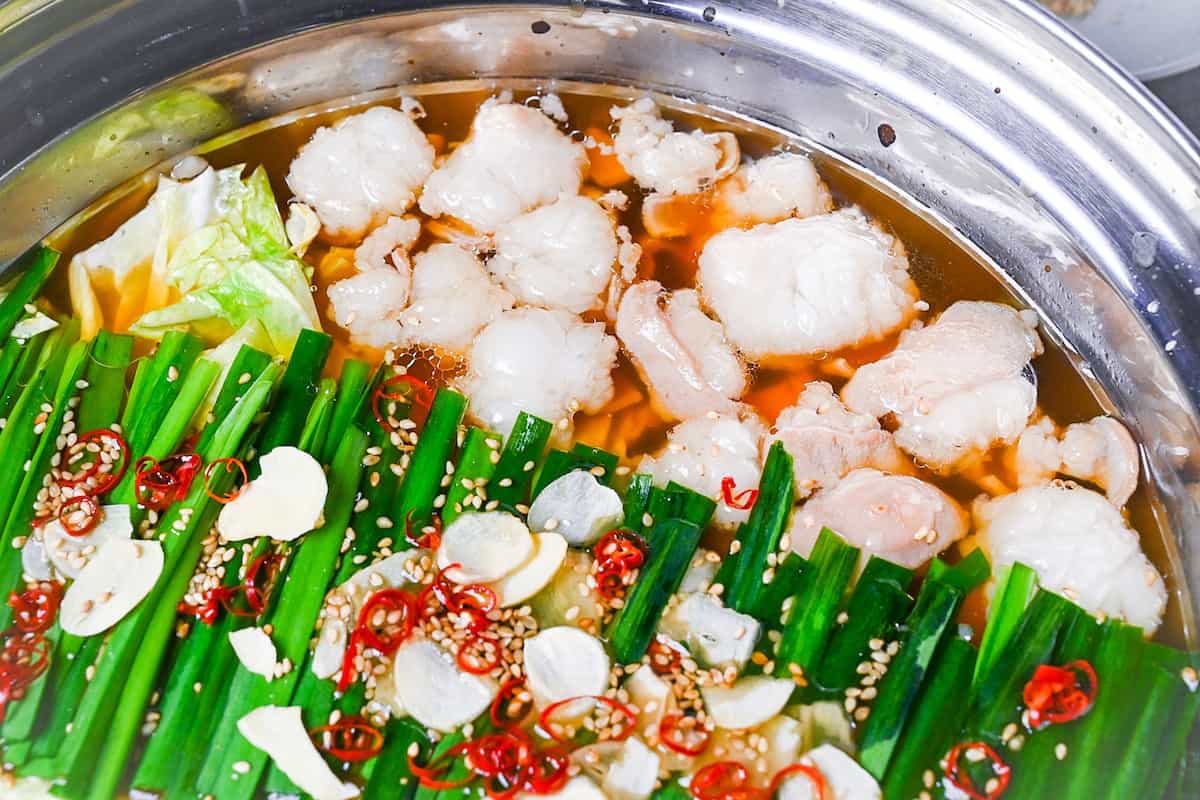
I hope you enjoy this Motasunabe recipe! If you try it out, I’d really appreciate it if you could spare a moment to let me know what you thought by giving a review and star rating in the comments below. It’s also helpful to share any adjustments you made to the recipe with our other readers. Thank you!
More Japanese Hotpot Recipes
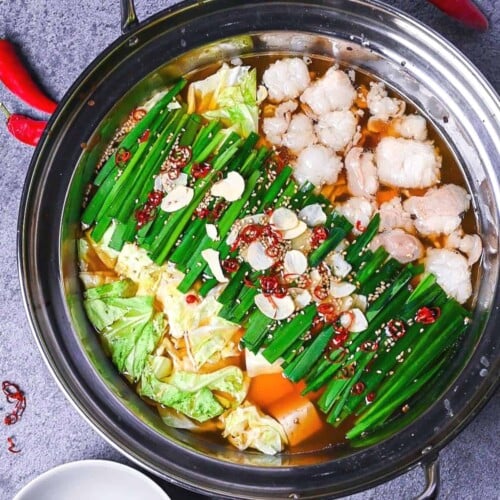
Hakata Motsunabe (Japanese Offal Hot Pot)
Ingredients
- 200 g beef offal (mostu) preferably small intestines cut into bitesize pieces
- 250 g green cabbage (white or pointed) roughly cut
- 50 g burdock root (gobo) (gobo)
- 150 g firm tofu cubed
- 100 g garlic chive(s)
- 1-2 dried red chili pepper thinly sliced
- 1 tbsp garlic chips or dried garlic slices
- 1 tsp toasted white sesame seeds
- 2 tsp ground sesame seeds optional
- 2 portions cooked ramen noodles thick type (champon) – wash after cooking to remove excess starch
Broth
- 800 ml dashi stock
- 2 tbsp Chinese-style chicken bouillon powder
- 4 tbsp Japanese light soy sauce (usukuchi shoyu)
- 2 tbsp Japanese dark soy sauce (koikuchi shoyu)
- 3 tbsp mirin
- 2 tbsp sake
- 1 tsp oyster sauce
- 1 tsp grated garlic or garlic paste
- 1 tsp grated ginger root or ginger paste
- 1 tsp light brown sugar
My recommended brands of ingredients and seasonings can be found in my Japanese pantry guide.
Can’t find certain Japanese ingredients? See my substitution guide here.
Instructions
- To wash the 200 g beef offal, place it in a bowl of cold water, swish it around and then pour it through a sieve placed over the sink to drain. Wash the bowl out, refill it with fresh cold water and set it aside.

- Fill a heatproof bowl (or large pot) with freshly boiled water and place the sieve with the offal in the water. Submerge for 10 seconds, then lift it up and shake.

- Pour the offal back into a bowl of fresh water and swill it around. Set aside for later.

- Take 50 g burdock root (gobo) and scrape off the skin using the back of a knife. Thinly slice diagonally and soak in water for 5 minutes.

- Take a large pot and add 800 ml dashi stock, 2 tbsp Chinese-style chicken bouillon powder, 4 tbsp Japanese light soy sauce (usukuchi shoyu), 2 tbsp Japanese dark soy sauce (koikuchi shoyu), 3 tbsp mirin, 2 tbsp sake, 1 tsp oyster sauce, 1 tsp grated garlic, 1 tsp grated ginger root and 1 tsp light brown sugar. Mix well and place the pot on the stove. Bring it to a boil over a medium heat.

- Once boiling, turn the heat down to simmer and add the drained beef offal, drained burdock root, 250 g green cabbage and 150 g firm tofu. Simmer until the burdock root and cabbage are slightly softened.

- Sprinkle 100 g garlic chive(s), 1-2 dried red chili pepper, 1 tbsp garlic chips and 1 tsp toasted white sesame seeds over the surface. Mix and simmer for a few minutes to allow the flavors to be absorbed into the broth.

- Divide 2 tsp ground sesame seeds between each serving bowl.

- Use a ladle to distribute the motsunabe between the serving bowls, and enjoy until there are no ingredients left in the broth.

- Place 2 portions cooked ramen noodles in the leftover broth.

- Enjoy!
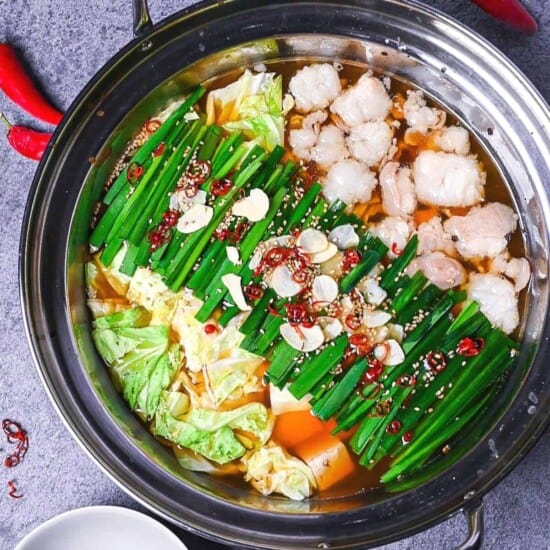



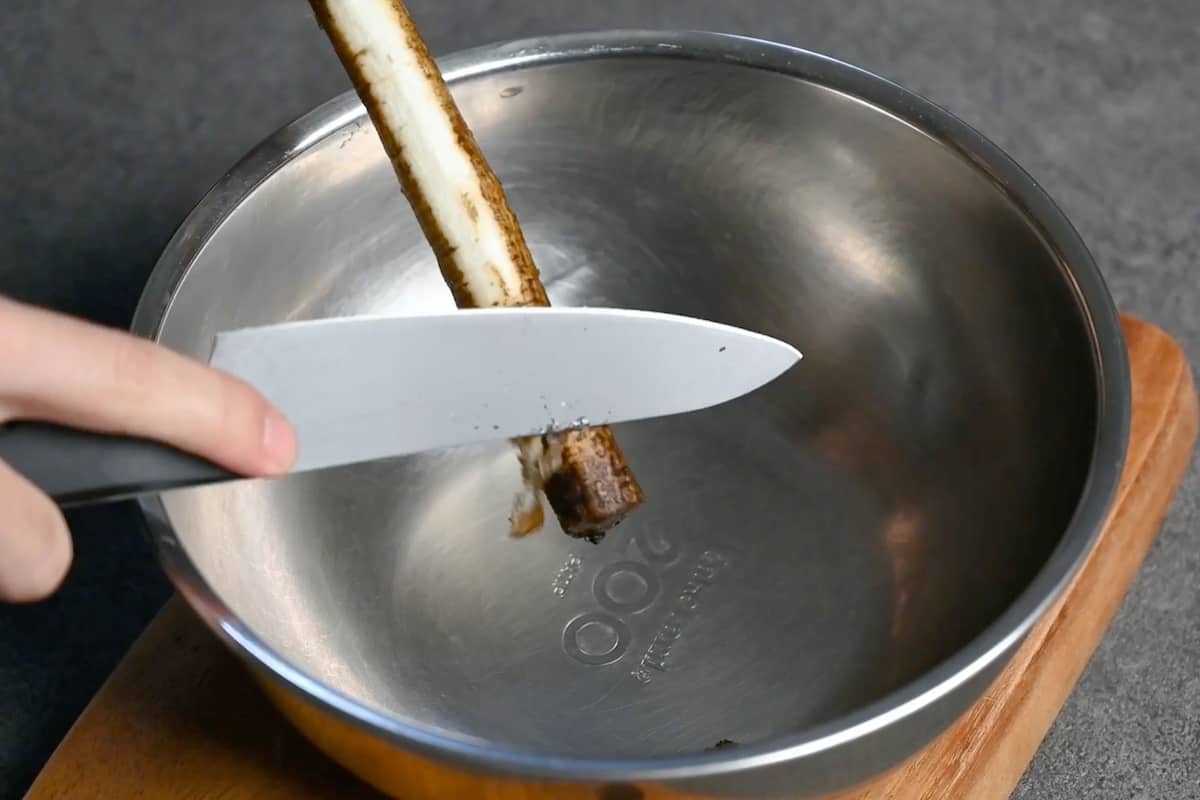
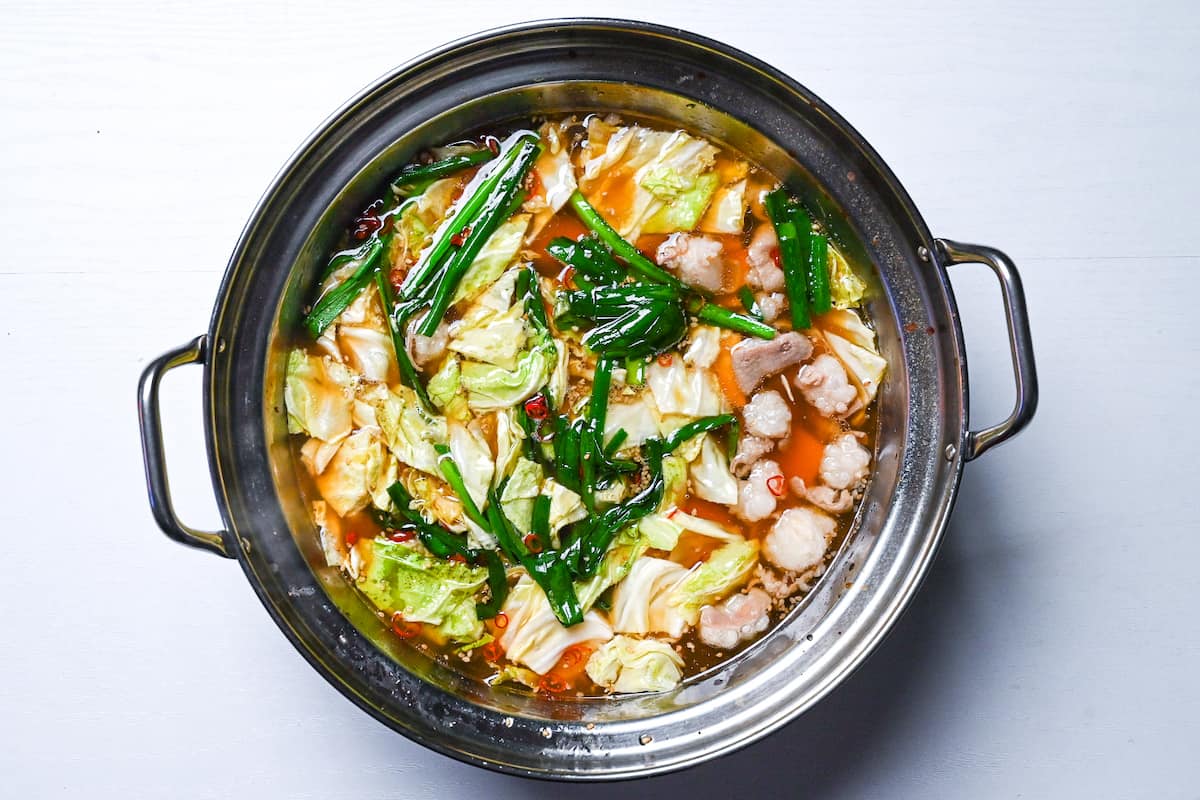
Thank you for your recipe. We really enjoyed it. The only thing we changed was adding more chilies.
Hi Hai,
Thank you so much for trying this recipe! I’m glad to hear you enjoyed it! 🙂
Yuto